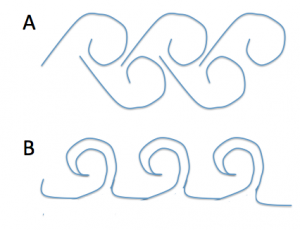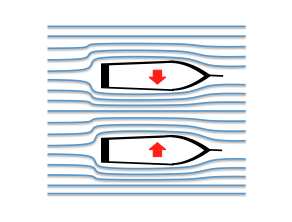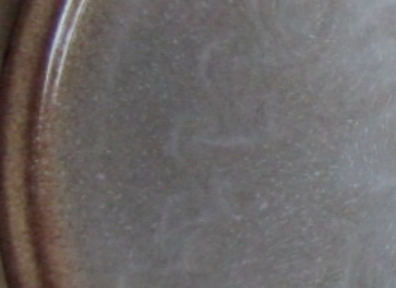That was quite a teaser on Wednesday, wasn’t it? I said I had the solution to any hydrodynamics problem you might want to illustrate. So here we go:
I recently had the privilege to be given a private demonstration of the “Elbe” flow solver, which is being developed at Hamburg University of Technology. Elbe allows for near real time simulation of non-linear flows, and can be run in an interactive mode.
Look at the Karman vortex street below (their movie, not mine!) – doesn’t it remind you of the vortex street on a plate?
Now. How can we use such an awesome tool in teaching?
There are a couple of scenarios I could imagine.
1) Re-create flow fields.
This is mainly to help students get “a feel” for how a flow reacts to obstacles.
Provide students with a picture of a current field and ask them to recreate it as closely as possible. This is not about creating the exact same field, but about recognizing characteristics of a flow field and what might have caused them. Examples could include a Karman vortex street or a Kelvin Helmholtz instability.

Possible sketches of A) Karman vortex street and B) Kelvin Helmholtz instabilities as examples for flow fields that students could be asked to recreate using Elbe.
In the above examples, students need to recognize, for example, that while a vortex street can be formed in a single-phase flow, a Kelvin Helmholtz instability typically forms on the boundary of layers of different densities in a shear flow (but could also form in a single continuous fluid), and recreate this in the model.
2) Visualize hydrodynamic concepts.
Here we would name a concept and ask students to set up a flow field that visualizes it. They might submit an annotated snapshot, for example. Possible examples are
– difference between stream lines, path lines and streak lines
– hydrodynamic paradox
– dead water

Hydrodynamic paradox. Moored ships are pulled towards each other because the flow is faster between them than upstream of them. (yes, the current in the picture is coming from the left, yet the ships are drawn as if the current was coming from the right. Shit happens.)
3) Test engineering applications.
Here we could imagine giving students different shapes and asking them to find their optimal position in a flow field, for example the pitch of a given wing profile to maximize lift, or the relative placement of a ship’s hull and a submerged ball for maximum canceling of waves.
4) Understanding of limitations of model and/or theory.
In some cases, students might be able to find optimal solutions from theory. In those cases it might be interesting to have them model those solutions and compare results with theoretical values. Can they come up with reasons why the modeled answers are likely different from the theoretical ones?
—
So far, so good. But how do we make sure that students don’t spend an insane amount of time fiddling with the nitty gritty details of the model, but focus on understanding hydrodynamics?
Combination of individual and group work
One idea might be to have students work individually on defining the important parameters (for example one- versus two-phase flow, obstacle at fixed position or moving, shape of obstacle) and then have them work in groups on putting those parameters into the model. If we were to grade this, we could give individual grades for individual answers to the first part, and then add a group grade in form of bonus points for a good model.
Model as a tool rather than the ultimate goal
Another idea would be to let them use the model as a tool rather than as the final application. As in students could be allowed to play with the model in order to, for example, figure out an approximate shape of an obstacle, and then they sketch their solution and annotate (e.g. “The longer X, the less turbulent region Y”). This would let them experience and explore hydrodynamics.
Peer-review
Whether or not a concept has been visualized well can be judged by the instructor, or it can become a learning activity in itself, for example as peer-review. Figuring out whether a visualization is correct or how it could be improved supports a deeper understanding of the concept as well as all kinds of interpersonal skills. In order to keep this interesting for students, several concepts could be visualized by different students and it can be made sure that the one students work on themselves is not the same as the one they will review later.
I am really excited to really start developing ideas on how to use this model in teaching. How would you use it?
